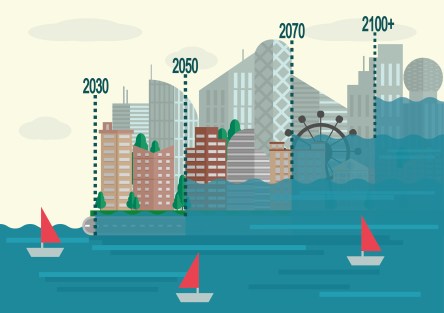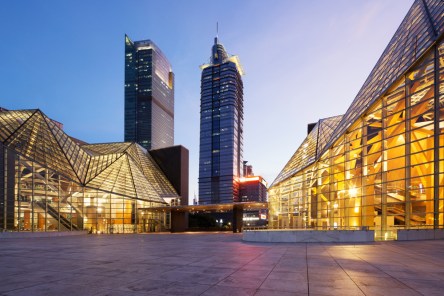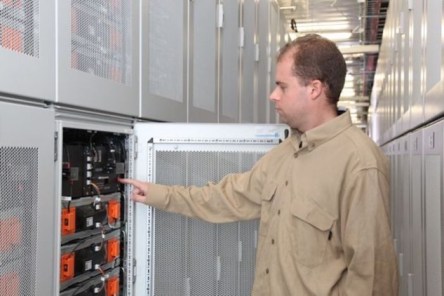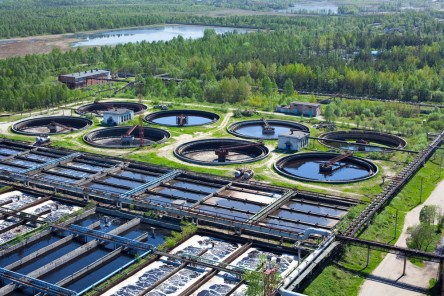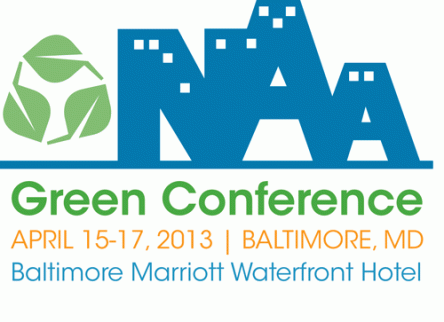Intense climate and weather-related events, such as hurricanes, hail and ice, heat and wind and inland flooding, are occurring around the world with alarming intensity. Three hurricanes in 2017 alone caused a combined $300 billion in damages. About 5 million people in the U.S. are within 4 feet of a local high-tide level. A United Nations report in 2016 noted that climate-related events could place real estate assets valued at $35 trillion at risk by 2070—about half of today’s global assets under management in any industry sector. By one estimate, a sea level rise of six feet would imperil U.S. coastal properties worth about $900 billion. How can real estate asset managers prepare for what could be an inevitable rise in sea levels and other manifestations of climate change? “Asset managers and investors already have access to energy efficiency data from providers like Yardi. Now they need project-level natural hazard data that includes climate change projections. This is something the climate resilience field is working on, with a variety of firm jockeying to be first with the rollout of their proprietary software,” says Joyce Coffee, president of Climate Resilience Consulting and a senior sustainability fellow at Arizona State University’s Global Institute of Sustainability. Some cities, such as Cedar Rapids, Iowa, are countering weather damage risk by building flood control systems. Other metros, like Philadelphia, Detroit and Washington, D.C., have increased sewage fees, spurring building owners to consider adopting more stringent water conservation efforts. Many other officials and private citizens, of course, focus their efforts on identifying and mitigating sources of climate change. Real estate investors, for their part, are incorporating climate risk into their analysis and avoiding risky investments. A whitepaper released by BlackRock in 2016 noted, “Investors can no longer ignore climate change....
Better Buildings
LA Leads Energy Efforts
A recent report presented by Better Buildings®, an initiative of the U.S. Department of Energy, and Global Real Estate Sustainability Benchmark (GRESB), an association dedicated to assessing and improving the sustainability performance of real estate assets, offered insight into the impact of sustainability certifications on commercial properties’ business performance in Los Angeles. David Hodgins, executive director of Los Angeles Better Buildings Challenge, presented findings showing that Class B buildings in Los Angeles with ENERGY STAR scores of 75+ achieved significantly higher occupancy rates and rent per square foot than non-certified Class A buildings there. Better Buildings’ findings were based on data from 263 ENERGY STAR-certified buildings and 526 LEED Certified buildings that illustrated the impact of ENERGY STAR benchmarking and certification on building occupancy and rental income. Co-presenter Dan Winters, head of Americas at GRESB, indicated the numbers are similar in other cities where studies have been done. Among the other Los Angeles findings: The average occupancy for ENERY STAR-certified buildings is 90%, vs the 84% current overall occupancy rate, which generates substantial gross annual rent increases The gross current asking rent per square foot (PSF) for ENERGY STAR buildings is $2.15, vs the current asking rent of $2 which also generates substantial gross annual rent improvements Los Angeles is benchmarking its most energy-intensive facilities and has pledged to reduce the energy intensity for 30 million square feet of city-owned and private buildings by 20% by 2020. More than 25 owners of large commercial buildings joined the challenge and report their results annually to help others save money and energy. The Los Angeles Existing Buildings Energy and Water Efficiency ordinance (EBEWE) has made energy efficiency a high priority in the city. This focus is paying off in multiple ways. The city ranked No. 1...
Energy Engagement
AT NAA Apartmentalize
A recent National Apartment Association study about apartment residents’ familiarity with and attitudes toward energy efficiency was the focus of an energy management panel at the recent Apartmentalize Powered by NAA conference in San Diego. The “Get Residents and Keep Them with Energy Efficiency Engagement” panel featured Martin Levkus, regional director for the Yardi Smart Energy Suite; Lexie Goldberg, senior associate for sustainability at Greystar; and Mary Nitschke, director of ancillary services for Prometheus Real Estate Group. Jenifer Paneral, senior vice president of operations at DayRise Residential LLC, served as the moderator. Last fall, NAA commissioned the Shelton Group to conduct a survey of 1,000 renters to understand the role of energy efficiency in choosing and staying in an apartment. The results were shared in Units magazine in June 2018 and presented to session attendees at Apartmentalize. The study revealed that property managers and owners can maximize resident engagement with energy efficiency. The study also found that mentioning energy efficiency at the first touchpoint is an opportunity to “get residents.” Twenty-five percent of residents participating in the survey said that knowing an apartment’s energy efficiency impacts their rental decision. According to Levkus, property managers can promote sustainability by making it convenient—and the key to convenience is technology. “Providing a portal that allows residents to easily view their consumption and pay their bills online empowers them to make changes that save money and make the property more sustainable,” he said. “Renters also like smart devices such as thermostats that increase their comfort but also reduce consumption and save money. The thermostats power down heaters and air conditioners when the unit is unoccupied.” Goldberg spoke of the importance of making energy and sustainability prominent on a property website. She described a Greystar community’s home page that...
Society of Women Engineers
Marisa Ceppi, Yardi Energy
Engineers are the brain and muscle behind the Yardi technology that makes property management (and property managers’ lives) easier. When Marisa Ceppi proposed the idea of presenting at the Society of Women Engineers 2018 National Conference (We’18), it was met with unbounded support from her teammates. The SWE We ’18 Conference Ceppi, Yardi Energy Account Executive, has been a member of the Society of Women Engineers (SWE) for more than a decade. She sees it as a way to encourage other young women to pursue science, technology, engineering and mathematics (STEM) career paths. “The amount of women engineers hasn’t really changed since I was an undergrad,” Ceppi observed. “It’s still a male-dominated career so one of our missions is to provide members with a network of women who are on the same path, facing similar challenges.” The annual conference hosts 14,000 attendees from across the United States. Participants receive networking and educational opportunities through events and carefully curated sessions. Conference sessions address challenges in the industry, new technology developments, as well as topics like leadership, strategic planning and work-life balance. “There is also a tremendous amount of best practice sharing between members and across the SWE organization. How can we improve? How can we make more of an impact in the communities that we live and work in?” said Ceppi. When approved, Ceppi, Annette Durnack, Christy Cannon, and Ankita Gupta, all part of the Yardi Energy Commercial Team, will lead a presentation entitled Not Your Mothers’ Air Conditioner: IoT and the Evolving Energy Industry. “We want to bring an educational component to the conference, sharing information on how Yardi is making an impact in the artificial intelligence environment. We will discuss how AI is changing our world, not just the energy industry but other industries as well,” said Ceppi. The presentation will include details on energy’s changing landscape, real world examples from Yardi customers, and how those customers benefit from Yardi energy management tools. “Also, we will talk about how the Yardi Energy Suite uses data in different ways and different levels of complexity. We will explore how the IoT is impacting the software industry. We’re also promoting career paths within the energy industry. This is a very exciting time in the energy field! We are tackling challenging problems and we need diverse brainpower to solve these challenges.” A Decade of Service The conference is one of many ways that Ceppi engages with SWE throughout the year. She participates in the Girls Exploring Science, Technology, and Math (GESTEM) event in Denver, CO. Now in its 15th year, the event hosts 40 hands-on workshops for more than 1,000 Denver area middle school-aged girls. “SWE outreach events works with girls of all ages but targets middle school age, since that is when girls start determining what they’re good at, classes that they want to take in high school, and potential career paths,” explained Ceppi. The free GESTEM event allows attendees to participate in three workshops per day, each requiring hands-on interaction and teamwork. “We want to show these girls that STEM careers involve working with people and helping people solve problems, it’s not just about math,” said Ceppi. “The workshops cover a broad spectrum of career options like technology, building bridges, aerospace, and designing circuit boards,” Ceppi said. “We want to expose girls to STEM who might not be exposed to such career paths at home. They may not have a parent who can take them to science museums or they can’t afford it.” GESTEM is a completely volunteer-driven event. More than 15 volunteers serve on the planning committee and 400 volunteers support the day of the event. The Rocky Mountain Section of SWE not only plans and hosts the event, but also raises funds from corporate donors to cover its costs. Ceppi also serves as a judge at the FIRST Robotics competition. “I interface with kids in fourth through eighth...
BOMA W2 Challenge
Water + Waste Reduction Effort
A grant from Yardi is helping owners and managers of hundreds of properties improve water and waste management practices in a Water and Waste Challenge program sponsored by the Building Owners and Managers Association International. The W2 Challenge is a two-year initiative designed to benchmark water and waste consumption and associated costs, and then develop new best practices for improvement. This year is dedicated to establishing a baseline using ENERGY STAR® Portfolio Manager® and 2019 will be focused on implementing performance improvements. Seventeen hundred properties signed up for the program so far. “Owners, operators, tenants and investors all have a stake in maximizing a building’s performance, and interest in the program has exceeded all expectations. The W2 Challenge is a unique opportunity to gain full understanding of water consumption and waste management, and take the industry’s sustainability efforts to the next level,” said Ken Rosenfeld, director of state and local affairs for BOMA International. “The program’s tips, tools and resources can help participants compare their performance to that of their peers, identify opportunities for improvement and reduce operating costs. Participants will also earn recognition for their leadership on this issue, including visibility at a future BOMA International Conference & Expo, use of the program logo and the opportunity to be featured as success stories that will be published in BOMA publications.” The Yardi Smart Energy Suite provides tools that can help building owners and operators obtain maximum value from the W2 Challenge, starting with automated data capture. For example, Yardi Utility Expense Management captures cost and consumption data directly from utility company invoices and Yardi Utility Billing allows companies to recover utility costs directly from tenants through submeter installation, maintenance and data administration services. Once the data is easily captured, building operators use Yardi...
Green Lease Leaders
Energy Best Practices
Commercial building owners, tenants and brokers need the right tools to incorporate energy efficiency into leases. A program called Green Lease Leaders stands ready to provide them. Green Lease Leaders helps real estate practitioners create leases that promote collaboration on investments such as high-efficiency rooftop air handling units, lighting retrofits, water irrigation upgrades and solar panels. The program was the subject of a recent webinar, “How to Become a Green Lease Leader: The Latest in High-Performance Leasing Practices and Recognition.” Presenters included Holly Carr, a Department of Energy technology program specialist, Sara Neff, senior vice president of sustainability for Yardi client Kilroy Realty Corporation, and Alexandra Harry, program manager, market engagement for the Institute for Market Transformation (IMT). Green Lease Leaders was developed in 2014 by IMT, a Washington, D.C. nonprofit and the webinar’s host, with support from the Energy Department’s Better Buildings Alliance. IMT works to unlock building energy efficiency that it says could save the U.S. office market $3.3 billion annually and cut energy consumption by 22% in leased buildings. The program currently includes landlords, tenants and brokers who represent 1.3 billion square feet of commercial, industrial and retail space. “Tenants and landlords share an obligation to understand how much energy their buildings use and jointly share the cost of upgrades as well as the resulting maintenance savings and best practices,” Carr said. “Benefits of green leasing include reducing utility bills by up to 51 cents per square foot, increased net operating income, reduced occupancy costs, increased occupant satisfaction, fewer greenhouse gas emissions and improved landlord-tenant communication and relationships.” Along with defining new best practices for energy efficiency in buildings, the program also offers participants technical support, peer networking opportunities, tools for comparing current leases to Green Lease Leaders standards and other...
Countering Threats
To Smart Buildings
A panel of corporate security experts held a recent Realcomm-hosted webinar to discuss strategies for managing cyberattacks to buildings that are increasing in frequency, sophistication and impact. Don Goldstein, senior vice president of IT for CBRE, recounted how the “Not Petya” ransomware attack of June 2017 encrypted hundreds of thousands of computers around the world and shut down whole networks and systems for weeks. With the damage still being added up, the initial $850 million economic cost estimate could rise. “Not Petya hit all verticals, from nuclear plants and pharmaceutical firms to steel makers, consumer lenders and law firms,” Goldstein said. Cautioning against disaster fatigue, he added, “We need to get people to think about and prepare for this type of event.” Ryan Allbaugh, business initiatives consultant for Wells Fargo, said that because internet of things (IoT) connected devices don’t have traditional IT operating systems or antivirus and antimalware, cyberattacks are “no longer an IT problem, but an operational problem” for every part of the economy. As we see more IoT connections, everything is vulnerable, from remote lighting control to elevator and video surveillance controls, Allbaugh noted. “The challenge with IoT is that these systems often lack centralized visibility, and doing something as simple as getting a physical inventory can be a challenge,” especially with widely dispersed properties. He outlined the National Institute of Standards and Technology Cybersecurity Framework, which offers guidance on assessing and improving prevention, detection and response to cyberattacks. Lorie Wigle, general manager for Intel, noting that “one company can’t solve this on its own,” urged collaboration and information sharing among IoT participants. “We need to have ongoing lifecycle security management services in place to continue to measure and detect compromises to components of end-to-end services,” she said. Given that there’s...
Tech Evolution
New Truths for CRE
Alex Stanton, Yardi industry principal for Commercial, joined other technology experts in exploring the fast-paced evolution of technology, automation and innovation in a recent Realcomm-sponsored webinar. The six-member panel described the current real estate technology paradigm that considers tenants, guests, employees and shoppers as interrelated elements of a user experience. As a result, property owners and managers aim to deliver a high-value experience by using new property management software systems that can capture and apply data inclusive of all occupant touchpoints, from reservations to parking to the building environment. Stanton elaborated on this theme, noting the convergence of historically separated property management technologies for property and facilities maintenance, energy management, procurement and self-service experiences. Amid rising expectations of among space and asset users, he said, “facility, property and business management systems are coming together,” allowing inventory management, preventative maintenance and exceptions management from a core suite. Additional technology innovations include “interfaces that enable experiences, such as service requests, photo-enabled technology for notifications, concierge services and payments, with immediate download of supporting photographs,” he said, adding, “Yardi sees tremendous opportunity in artificial intelligence, the internet of things and visualization.” Addressing another part of creating an optimal building experience, Stanton referenced Yardi’s creation of an energy suite that encompasses everything from energy optimization, sourcing, utility expense management and compliance. Other speakers addressed other drivers of real estate technology innovation. Rick Gehringer from real estate developer Caruso related how a common technology platform can provide “a true experience management system” for guests by capturing all touchpoints and every user engagement across a property. Examples of how technology can make the guest experience enjoyable, efficient and high-quality include a common reservation system, a rewards system that captures receipt images and an automated parking system. John Gilbert of commercial...
Return on Energy
Upgrades for Efficiency
Want to cut costs on energy? The National Apartment Association (NAA) Education Conference session entitled Return On Energy: Sustainable Case Studies for Catching Up offered several helpful tips for keeping costs low and residents happy. The session featured Martin Levkus, Regional Director, Yardi Energy; Tom Turnbull, Senior Engineer, JDM Associates; and moderator, Erin Hatcher, LEED Sustainability Manager & Development Associate with AMLI. Hatcher kicked off the session with a question to the audience: “in-house or out-of-house?” Some multifamily owners and operators, like AMLI, have the infrastructure in-house to do their own sustainability and energy efficiency projects. Others, need to outsource to experts if they don’t have the personnel or expertise to do it all themselves. Although both methods have pros and cons, there are some key tips that either method can use to help your properties operate optimally. Data + Analysis = Cost Savings You can’t improve what you can’t measure. Yardi has helped numerous businesses decrease utility expenses with the help of software and Levkus’ advice: “It all starts with a utility bill.” Before you can take down the low hanging fruit, you need to use data to identify it. Levkus referred to a case study including 14,600 units across 260 properties. The organization spent $50,000 – $100,00 in late fees each year. With better bill processing integrated into one software solution, they reduced late fees for roughly $75,000 in annual savings. Beyond paying the utility bills on time, you also want to make sure the bills have accurate charges. A separate Yardi study revealed that for a residential property management business spending $32 million per year on utilities across 63,000 invoices, there were significant billing errors by the utility company equallying $388,000 across two years – 0.55 percent of spend. Yardi’s goal...
Energy Management
Future of Savings + Retention
Transparency Market Research reports that the global energy management systems (EMS) market continues to grow. The market will show an estimated compound annual growth rate of 13.4 percent between 2015 and 2023, leading to a valuation of $36 billion by 2024. The estimate reflects ongoing confidence in the benefits of sustainable initiatives. Increasing Demand Several factors contribute to the rising demand for EMS. Current fossil fuel sources lack security and sustainability. The long-term projections by the International Energy Agency forecast a rise in such energy costs. As a result, organizations—particularly office, retail, and industrial spaces– strive to mitigate rising expenses by decreasing dependency on non-renewable fuels. Data gathered by EMS highlights opportunities for organizations to use less energy while maintaining optimal site performance. Smarter energy use will minimize waste and keep operating costs low. EMS also contribute to higher property values. The value of buildings with sustainable features exceeds the value of conventional structures by a median increase of 7 percent, reveals a joint study conducted by Dodge Data & Analytics, United Technologies Corporation, and World Green Building Council. The Drive Toward Healthier Buildings report states that 73 percent of green building owners are able to increase their leasing rates and 62 percent achieved higher asset values. EMS help buildings achieve and maintain the standards needed for green building certifications, increasing the ability to lease and resale sites with higher value and fewer concessions. The drive for increased productivity, employee satisfaction and retention also contributes to the increasing demand for EMS. Research points to occupant health as a component of employee satisfaction and retention. In The Drive Towards Healthier Buildings, 79 percent of respondents believe wellness-focused buildings will lead to improved employee satisfaction. Business owners listed products that enhance thermal comfort, such as EMS, among the...
Benchmarking Bonus
NAA Return on Energy
Currently, over 45% of the US commercial building market uses the ENERGY STAR®, the US EPA’s voluntary certification program designed to measure energy efficiency and improve resource management. At the heart of ENERGY STAR® lies the ability to track energy usage data to reduce energy consumption and improve building performance. “It all starts with taking a look at what you have and seeing what [information] you’re tracking and what data is available,” Craig Haglund, Program Manager, for the US EPA’s ENERGY STAR program, said in the National Apartment Association’s recent webinar, Financial Success with Energy Benchmarking. With comprehensive data collection and analytics capabilities, US EPA’s Portfolio Manager works in concert with ENERGY STAR for complete resource management oversight. “They say ‘you can’t manage what you can’t measure,’ which is 100% true,” Haglund continued, “but that misses what you can do with all that data.” Whole Building Consumption For building owners and managers interested in tracking their energy, water and waste metrics, ENERGY STAR provides an easy, comprehensive management tool: Portfolio Manager. With Portfolio Manager, building data can be tracked and analyzed. Users can create customized reports and monitor changes in energy, water, greenhouse gas emissions and more. “Portfolio Manager literally includes hundreds of measurement metrics,” explained Haglund. “Standardized reports can help users assess portfolio performance and share that information or integrate it into other presentations.” Those measurement metrics can be applied to any sized property portfolio, from one building to, in the case of East Coast real estate services firm Bozzuto Management, 63,000 units spread out over 220 communities and representing 2.1 million square feet of mixed-use development. “We have been using Portfolio Manager since 2012,” said Bozzuto’s Director of Sustainability, Peter Zadoretzky. “Over the last couple of years, we’ve gone from a messy,...
Grid-Sized Storage
Energy Efficiency
Late last month, Southern California Edison switched on its newest substations, an 80MWh lithium-ion battery storage facility that will manage peak demand and improve grid reliability. Just off Interstate 15, nestled in the heart of California’s Riverside County, one of the world’s biggest energy storage projects recently roared to life. Part of a collaboration between Tesla and Southern California Edison (SCE), the installation at the Mira Loma substation will be used to manage peak energy demand and stabilize the grid. “Upon completion, this system will be the largest lithium-ion battery storage project in the world,” declares a Tesla blog post announcing the project. “When fully charged, this system will hold enough energy to power more than 2,500 households for a day or charge 1,000 Tesla vehicles.” Managing Peak Energy The Mira Loma project is one of the first to use Tesla’s new Powerpack 2 for utility-scale energy storage. With an 80 MWh capacity, the 400 Powerpacks will allow SCE to manage energy use during peak hours. The Powerpacks will be charged with electricity generated during off-peak hours and then supplement demand during periods of peak demand. This process will not only save energy; it will allow SCE to maintain grid reliability, deliver better power quality to customers and reduce dependence on fossil fuels. “The system will charge using electricity from the grid during off-peak hours and then deliver electricity during peak hours to help maintain the reliable operation of Southern California Edison’s electrical infrastructure which feeds more than 15 million residents,” explains the Tesla statement. “By doing so, the Tesla Powerpack system will reduce the need for electricity generated by natural gas and further the advancement of a resilient and modern grid.” Future Expansion Larger utility-scale energy storage projects are already in the works...
Earth Day
Inspiring Green Energy
In preparation for Earth Day on April 22, we are exploring a few ways to celebrate that can benefit your business while promoting sustainability. More than 190 countries celebrate Earth Day every year. Individuals, families, and organizations combine efforts to support sustainable initiatives. Aside from employee participation and donations, businesses largely miss out. The sustainable programs below offer notable benefits to for-profit entities. Yardi Smart Energy Suite Yardi Smart Energy Suite includes products for total insight and management of your energy consumption and costs, including REC purchases and Yardi E2 Insight. Combining your energy initiatives into one platform for utility billing recovery, paperless utility invoice and payables processing, HVAC optimization and smart thermostats, let’s you leverage the data with your property management information for better results. The mobile-ready stack of energy management solutions can be customized to meet your needs and facilitate the greatest cost savings for your company–without sacrificing tenant or employee comfort. Yardi E2 Insight You can’t manage what you can’t measure. Yardi E2 Insight collects cost and usage data down to the individual building meter. The reports generated allow you to precisely measure and moderate your energy usage. Program analytics can be adjusted to account for seasons, building size, occupancy, and other factors to ensure that you report the true performance of your assets. Modules within Yardi E2 Insight dashboard facilitate easy benchmark reporting. Get effortless access to the data that you need to complete complex reporting requirements. Such reports can help your company qualify for portfolio-wide certifications issued by GRESB and ENERGY STAR® Portfolio Manager®. For more on Yardi E2 Insight, call (800) 866-1144 or request more information online. Renewable Energy Certificates (RECs) It is now cheaper than ever to offset the harmful emissions that your company generates. The prices...
Every Watt Counts
Benchmarking in the Big Apple
On December 28, 2009, New York City Mayor Michael Bloomberg signed Local Law 84 (LL84), mandating annual energy reports for any privately owned buildings over 50,000 square feet. (In October 2016, the city expanded LL84 and LL88 to include buildings 25,000 Sq. Ft. and higher, though, this doesn’t officially go into effect until 2018.) Enacted as part of the city’s Greener, Greater Buildings Plan (GGBP), LL84 was designed to help building owners not just measure energy use, but to develop actionable energy efficiency strategies based on that data. By the time the first benchmarking report was released in 2012, the city had gathered energy usage information from 1.8 million square feet of commercial and residential space, making it one of the largest accumulations of benchmarking data gathered for a single jurisdiction. “Buildings account for 75 percent of all greenhouse gas emissions in New York City, yet many property owners and managers do not know they [can] be a part of the solution and save money by making their buildings more energy efficient,” said Mayor Bloomberg in a statement after the first benchmarking reports were released in 2012. “This benchmarking report will help us understand where we can act most quickly to significantly reduce GHG emissions and achieve our PlaNYC goals.” Lights, Meters, Action Often considered the low-hanging fruit of energy efficiency implementation, improving a building’s lighting system can dramatically reduce energy consumption. In New York City, roughly 18% of energy use in non-residential buildings can be attributed to lighting, which also accounts for 18% of the city’s carbon emissions. With the goal of reducing greenhouse gas emissions by 30% within the next 15 years, Local Law 88 (LL88) was designed to address the need to encourage lighting upgrades for improved energy efficiency and reduced...
The Pulse of Energy
Yardi Energy
With the ability to collect, analyze and communicate real-time energy information, Pulse Energy adds the power of data to Yardi Energy arsenal. The Power of Data Over the last few years, Jeff Rambharack and the Pulse Energy team have worked to collect data on over a million businesses throughout the US and Canada. That data drives the company’s overall approach and helps provide Pulse clients with strategies tailored to their unique challenges. The company works with utilities and individual businesses, focusing on solutions specifically for different industry segments. “We provide personalized messaging for individual businesses,” explains Rambharack. “We support over 130 different verticals for businesses segments, and we provide personal messaging within each segment. We recognize that every business is different, and we work to identify sources of energy consumption and provide targeted recommendations layered on top of our in-depth analytics we’ve developed to analyze each business’s energy consumption.” Rambharack believes the biggest benefit of this data aggregation is that it allows an energy usage analysis at every level of a company’s organization. By being able to provide personalized insights about of those levels of aggregation, Pulse clients can pursue more effective energy management policies and procedures to reduce energy waste and improve energy efficiency. “Just being able to provide insights and say ‘Hey, you should go look at building X, because we think it has some efficiency problems,’ is so valuable to our clients,” says Rambharack. “Maybe we discover that they are leaving their systems on at night or running their AC and heating simultaneously. Our analytics and extensive database help us detect these sorts of oversights and provide valuable energy consumption insight to our customers.” Tracking Usage against the Baseline One of the most valuable tools for energy management involves developing an accurate...
Waste, Not Wasted
Creating Energy from Waste
Innovations in wastewater treatment improve energy efficiency through resource recycling and energy production. Restrictions on water use and carbon emissions require companies to get creative with resource management. Companies that simultaneously seek ways to cut overhead costs have two unique solutions from which to choose: Cambrian Innovation reports that the United States spends about 3 percent of its energy use in treating wastewater. Rather than letting the wastewater go to waste, the company has discovered a low-cost, low-energy method to recycle it. The Boston-based company created the EcoVolt Reactor, a wastewater treatment system. The process results in potable water with minimal energy use. Natural methane gas, which can be used for fuel, is a byproduct of the treatment. EcoVolt Reactors give old technology a fresh, efficient twist. In traditional setups, energy is used to create bubbles that oxygenate and disperse microbes through wastewater. The microbes remove contaminates at the expense of high energy usage. The EcoVolt Reactor uses a different family of microbes that does not need air to work. As a result, users do not need to use energy to produce bubbles and agitate the water. Instead, the wastewater is poured through a filter that contains the microbes. Methane gas (and carbon dioxide that is converted into methane) are released through the chemical process. The fuel is trapped and used for other operations in the building. EcoVolt Reactors generate anywhere from 40KW to 300KW of energy depending on the number of modules that are linked together. Cambrian Innovation Founder and CEO Matt Silver estimates that a chain of reactors could provide nearly 20 percent of the energy required by the average American company. There are currently ten active EcoVolt Reactors throughout the US. In Scotland, Sharc Energy Systems produces clean, hot water using...
Enhancing Energy Efficiency
Get the new ebook for greening multifamily
Yardi Energy focuses on energy management and sustainability for real estate, including commercial, retail and residential buildings. Yardi offers several products as part of the Yardi Smart Energy Suite, most of which are built into Yardi Voyager property management software, offering its clients a unique experience utilizing a single stack of products to effectively manage assets, analyze energy costs and deliver energy savings. Yardi Utility Billing and YardiUtility Expense Management helps with the recovery of utility costs from residents and vacant units, and automates paperless utility payables processing. Yardi LOBOS and Proliphix includes HVAC energy optimization software for commercial and retail buildings. Pulse Energy provides real-time energy data aggregated by a built-in algorithm for visibility into energy load to manage energy use, performance, and occupant engagement. Yardi PowerShopping energy procurement services leverage energy management and risk management strategies to negotiate competitively priced electricity, gas, oil and green energy sources on behalf of property operators. We sat down with Martin Levkus, Director at Yardi Energy, to learn more about the energy initiatives he’s seeing in the multifamily sector. Executive Summary Yardi Energy works with both commercial and multifamily buildings, which has provided Levkus with an interesting perspective on sustainability in the real estate space. He says the multifamily sector lags behind the commercial sector when it comes to sustainability due to a difference in who pays the bills (residents in the multifamily sector versus property owners in the commercial sector) and a lack of quantifiable whole-building data in the multifamily sector. Still, Levkus has seen sustainability in the multifamily sector go through three phases of evolution. First was the submetering units to make residents directly responsible for consumption costs, second was educating residents on how to lower their consumption and third entailed views of whole building data to measure performance and compare buildings for energy trending, benchmarking and most recently tracking ENERGY STAR scores. Levkus also believes that we have reached a turning point when it comes to sustainability in the multifamily sector. More states are mandating energy benchmarking, and we have a new generation of environmentally conscious renters. Together, these factors make energy efficiency improvements more compelling. Against this backdrop, however, multifamily building managers must collect more energy data and make better use of it to improve visibility into consumption and help determine the impact retrofits will have on performance. Fortunately, says Levkus, there is plenty of innovative technology available to help. Specifically, he points to Internet of Things devices like smart thermostats that can make regulating energy consumption smarter and easier for residents and property owners alike. He also cites the value of new meters that can provide real-time visibility into utility data to help buildings proactively identify and correct any issues as they happen. Success comes down to making all of these factors — better data, new technology, improved visibility and resident participation — come together. Levkus contends: “Improving visibility into data and introducing Internet of Things technology will help property owners be more successful with energy initiatives in the multifamily market, but they can’t do it alone. Property owners can’t be successful in achieving any major energy goals or savings in the multifamily market if they don’t engage their residents. If you have a 200 unit building, your common area counts as probably 10-15% of the energy bill. The rest is in the hands of your residents, so if you don’t engage them with any sustainability projects, you’re not going to be able to succeed because they control 90% of the costs.” Want to read more? Download The Next Frontier for Energy Efficiency: “Greening” the Multifamily Sector now. What are some of the reasons why your clients seek out Yardi Energy’s services? Martin Levkus: Our customers look to our expertise to help them manage their energy and reduce their operating costs. Also, they use our Voyager property management platform as a “single stack” business solution....
Tips for Tips
Business Energy Management
Editor’s note: The following piece and accompanying graphics are re-published with permission from Home Energy Magazine. Behavioral recommendations, or tips, are an integral piece of many energy efficiency programs, ranging from marketing materials (e.g., brochures) to in-home audits, to Home and Business Energy Reports (such as the report shown below). Though information is known to be a critical component of effective interventions, it is important to consider human motivations and needs for this to be effective. This article synthesizes findings from a series of empirical research conducted by See Change Institute and Yardi (formerly Pulse) Energy’s Business Energy Report (BER) program[1]. By breaking apart the tips from the energy report (sample below) and breaking down the components of those tips even further, we were able to test the impact of variations of different components of tips, with the goal of optimizing messaging to incite pro-efficiency behavior in BER recipients[2]. In synthesizing these findings, we identified five key insights on tip content, form, structure, and imaging, or “Tips for Tips”. 1. Put People in Pictures First, we tested the impact of having people in images above the tips – one tip had a picture of equipment, the other included someone actually engaging in the behavior being promoted. We found that tips with an image of a person engaging in the action were rated significantly higher in terms of behavioral intention (that is, how much someone self-reports intention to complete the recommended action).We recommend considering images that do include people, especially people engaging in the recommended action. 2. Tell People What to Do Next, we tested the difference between a “subject title” (e.g., “Ceiling Fans”) and an “action title” (e.g.,”Use fans more & A/C less”). We found that using an action title led people...
Smart Renters
Want Smart Energy
Rising utility costs are a growing concern for renters. A recent report by Freddie Mac suggests that increasing utility costs concern renters more than rising rents—and renters are willing to pay higher rents for greener units. Forbes reports that the price of every energy commodity included in its index declined in the double digits since 2013. Electricity was the only exception with a decline of 0.4 percent. Energy costs are lower yet residents receive higher bills even when demand and usage have not increased. The changes are so alarming that concerns over rising utility costs now outweigh worries over rising rents. The “Profile of Today’s Renter” by Freddie Mac reveals that 70 percent of respondents are moderately to greatly concerned about higher utility bills. More than 60 percent share the same level of concern about potential rent increases. Utilities and rents are neck-in-neck when renters consider the impact on their budgets. Of participants, 74 percent report that higher utility bills will have a great impact or some impact on their household finances. In comparison, 78 percent express similar views about higher rents. What may come as a surprise is that 47 percent of renters are willing to pay higher rents for a unit that promotes energy conservation. Of those surveyed, 88 percent say that green multifamily properties will help to reduce their utility expenses. But that’s not the only reason why renters will invest more in a green apartment. The perceived and actual value of sustainable properties extends beyond renters’ utility bills. A remarkable 84 percent of renters believe that multifamily properties that invest in sustainable features are “better places to live.” For many, energy conservation is a logical, ethical, and moral preference. Yardi Smart Energy Suite for multifamily properties addresses renters’ concerns by...
Death to Power
The Changing Energy Industry
Editor’s note: This piece originally appeared in the fall issue of NAREIM Dialogues. Electrification is perhaps the greatest technological advancement of the 20th century. The electric power grid, the system that delivers electrification, is considered by many to be the largest and most successful machine ever built. But it may be about to die. The power grid “machine” is an interconnected system of long distance transmission lines, local distribution systems, transformers, substations, generating power plants, and the computers and control systems that manage it. In the United States, it delivers $400 billion in electricity annually over 7 million miles of power lines and through the efforts of 3,200 utility companies. The infrastructure in the system is valued at over $850 billion. Uptime is an astonishingly high 99.97% (I certainly wish my laptop could approach that level of reliability) and growth in the system is delivered relatively reliably by simply calling your utility. All this is delivered at price that is slightly below where it was in 1960 in real terms. This is an incredible success story; it seems like there is little here to concern real estate investors and owners…right? If only it were so simple. We have entered a period of incredibly rapid change in energy technologies, and the future of the utilities that deliver power to our buildings, and even the future of the electric grid itself, is in considerable flux. The forces threatening to disrupt the power grid include distributed solar systems, fuel cells, demand response technologies, battery storage, energy efficiency, electric vehicles, and various micro grid technologies. We can sum these up with the phrase: be your own power plant. Or to be cheeky, “adios, utility company.” Even if you think your particular investments, assets, buildings or properties won’t mess...
LOBOS
Enhancing Building Comfort
For facility managers, seasonal changes are always a challenge. External temperatures fluctuate. Occupant attire straddles the coverage spectrum. You can tell by the flood of emails that you receive (and the dirty looks that you get at lunch) that occupant comfort is not optimal. It doesn’t have to be that way. Occupant comfort is a tricky science. As a facility manager, you balance the temperatures between 72° – 76° F for your office spaces because you know the workers will be sedentary. In more active environments, like retail and schools, you drop the temperatures between 68° – 74° F. You know that these temperature ranges will keep about 90 percent of the occupants happy, which is the industry standard. Yet the ASHRAE recommended temperature ranges are broad enough to cause discomfort amongst the 90 percent, especially during changes in season. Biological differences play a role in comfortable conditions. Yardi LOBOS® (Load Based Optimization System) for commercial properties makes it easier to achieve optimal occupant comfort while saving energy even during seasonal transitions. LOBOS is an intelligent HVAC energy optimization software platform that can help you maximize efficiency, by automating demand management, peak load reduction. and demand response events. It does this by sending temperature, pressure, and speed set point adjustment signals to the existing HVAC components every 60 seconds to produce just enough cooling resources to satisfy the cooling demand in the spaces The LOBOS Cloud automatically stores HVAC trend data that operators find useful in creating a host of ad hoc reports of system operation and performance. The LOBOS software suite gives you a complete understanding of how your building is performing and automatically makes subtle real-time adjustments to maximize occupant comfort and energy savings. Adding LOBOS to an existing HVAC system typically...
Efficiency Reigns
Commercial Survey
If you haven’t prioritized the energy efficiency of your commercial properties, you’ve already fallen behind the curve. Corporate mandates requiring the lease of green buildings have nearly tripled. Prospects are willing—and now able—to pay a premium for energy efficient spaces. The Institute of Building Efficiency issued a survey to 687 VPs, facilities managers, owners and C-level personnel across the nation. Their buildings range from under 50,000 square feet to beyond 500,000 square feet. The results of the report revealed that energy efficiency has become a top priority and growing investment for building owners. When asked about their views on energy efficiency, 46 percent of survey respondents said they paid “a lot more” attention to energy efficiency in the previous 12 months than they had in prior years. Of the executives surveyed, 68 percent plan on increasing their investments in efficiency and renewables. In the past, third-party rebates and incentives furnished the bulk of financing for commercial efficiency upgrades. Yet with such resources dwindling, owners are earmarking monies within their own budgets. Financing called “energy- or climate-specific set-asides within the capital budget” nearly doubled last year to 30 percent from 17 percent in 2012. Meanwhile, energy service agreements increased to 32 percent from 21 percent in 2012/2013. The benefits of energy efficiency have proven their worth. Executives, managers, and tenants choose energy efficient buildings over conventional buildings. This year, 36 percent of respondents expressed that they would be willing to pay top dollar for an efficient space. This is more than double the 15 percent of participants who reported that they would pay a premium in 2013. Many are willing to pay the premium because efficient spaces are a mounting requirement by leadership. 10 percent of respondents reported that corporate policy mandates the lease of...
Choose Clean Power
Insight from MCEnergy
Evidence of climate change is all around us – for example, the amount of Americans with asthma has more than doubled in the past three decades, and rates are alarmingly high among lower-income people, who are more likely to live near a power plant. It’s no wonder that people are getting sicker when, as a country, we emit more than 5.5 billion tons of carbon dioxide (CO2) a year. As of August 2015, the Obama administration released a proposal to tackle this tremendous issue in the form of the Clean Power Plan (CPP). The plan sets the country’s first-ever national standards limiting carbon pollution from power plants, which were previously unregulated. The CPP aims to reduce carbon dioxide emissions by 32 percent by 2030 by establishing standards, but allowing individual states the flexibility to choose how this should be accomplished. With such a daunting goal, it can be confusing to know where to start when considering alternative energy for your properties. We caught up with Jennifer Burke, an energy consultant at Yardi subsidiary MCEnergy, to find out what this new plan means for the commercial real estate industry. How will the CPP affect commercial real estate? JB: The CPP is intended to reduce carbon emissions by 32 percent for U.S. power plants – below 2005 levels. Coal fired power plants are the greatest emitters of carbon. Therefore, the CPP will have the greatest impact to electricity pricing in geographic areas where coal is more dominant in the generation of electricity. The PJM ISO, the largest Independent System Operator (ISO) in the U.S., which encompasses 13 states in the mid-Atlantic region, has a relatively high concentration of coal fired power plants and will be impacted the most. As more coal plants are retired, there may...
MCEnergy Acquistion
Yardi purchases NY-based firm
Energy management software from Yardi® promotes efficiency and savings following the company’s acquisition of energy services provider MCEnergy Inc. Energy management services from MCEnergy include contract negotiations with leading electricity, natural gas, fuel oil and green energy suppliers to provide reliable energy at competitive prices. Turnkey submetering solutions and energy and environmental tracking software give property managers access to energy, environmental and sustainability data and information. MCEnergy’s product offerings complement existing Yardi solutions for utility billing, energy management, submeter data administration and intelligent HVAC energy optimization software. “MCEnergy has been providing market insights and energy management services to Class A commercial and industrial clients for nearly 20 years. Teaming with Yardi is a great opportunity to strengthen and extend our offerings on a national level and provide these services to the residential as well as commercial real estate communities. We are thrilled to join Yardi,” said Margaret M. Carey, president of MCEnergy. “Yardi continues to focus on advancing our clients’ energy-related objectives by providing options to actively manage consumption, cut costs and support environmental initiatives within a single full-business software platform. Acquiring MCEnergy is the latest step toward that goal, and we look forward to welcoming their energy, real estate and software expertise to Yardi,” said Gordon Morrell, executive vice president of Yardi. About MCEnergy Inc. MCEnergy, based in Valhalla, N.Y., is a world-class energy information and procurement company. MCEnergy helps clients secure energy at competitive prices, meter and track energy usage, calculate carbon footprints, institute green initiatives, manage data exporting for clients participating in the EPA EnergyStar Program and maximize recovery of utility revenue. The company advises hundreds of companies, from Fortune 500 to medium and small energy users. In 2005, MCEnergy was awarded the Women-Owned Business Enterprise (WBE) certification by New York...
Energy Management
2013 NAA Green Conference
Yardi’s Matt Miller will moderate the “Green Building and Utility Management – Doing it Right Makes Sense,” panel at the 2013 NAA Green Conference, planned for April 15-17 in Baltimore, Md. Panelists are William J. Greene III of Wood Partners, Manny Gonzalez of KTGY and David Woodward of CompassRock, industry leaders with strong backgrounds in utility management and green building strategy. Miller, industry principal for Yardi Energy Solutions™, will serve as moderator. The session will focus on how effective energy management can add value for property managers, investors and residents in the multifamily industry. Topics of coverage include the value of LEED certification, installation tips, the impact on properties of green planning and utility management, trends in energy management, the role of environmental practices in consumers’ rental decisions, and more. To learn more about the NAA Green Conference, visit...

